语法:过去分词作状语
人教版高中英语:Unit 3 Life in the future 语法归纳 过去分词作状语和定语
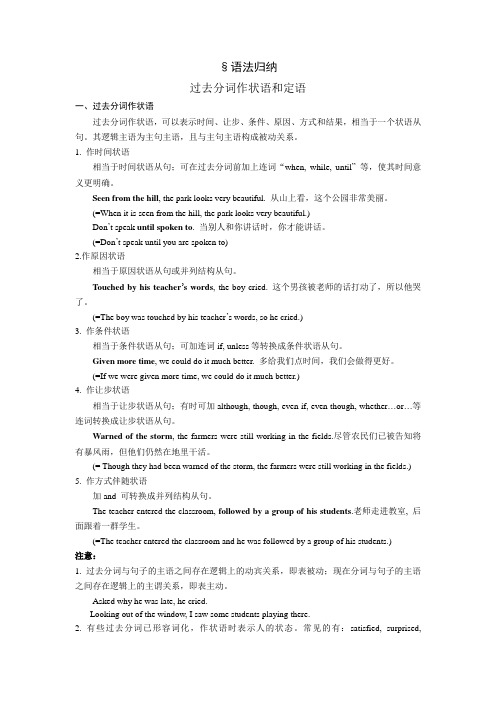
§语法归纳过去分词作状语和定语一、过去分词作状语过去分词作状语,可以表示时间、让步、条件、原因、方式和结果,相当于一个状语从句。
其逻辑主语为主句主语,且与主句主语构成被动关系。
1. 作时间状语相当于时间状语从句;可在过去分词前加上连词“when, while, until”等,使其时间意义更明确。
Seen from the hill, the park looks very beautiful. 从山上看,这个公园非常美丽。
(=When it is seen from the hill, the park looks very beautiful.)Don’t speak until spoken to. 当别人和你讲话时,你才能讲话。
(=Don’t speak until you are spoken to)2.作原因状语相当于原因状语从句或并列结构从句。
Touched by his teacher’s words, the boy cried. 这个男孩被老师的话打动了,所以他哭了。
(=The boy was touched by his teacher’s words, so he cried.)3. 作条件状语相当于条件状语从句;可加连词if, unless等转换成条件状语从句。
Given more time, we could do it much better. 多给我们点时间,我们会做得更好。
(=If we were given more time, we could do it much better.)4. 作让步状语相当于让步状语从句;有时可加although, though, even if, even though, whether…or…等连词转换成让步状语从句。
Warned of the storm, the farmers were still working in the fields.尽管农民们已被告知将有暴风雨,但他们仍然在地里干活。
高中英语语法—过去分词作状语讲义+练习题
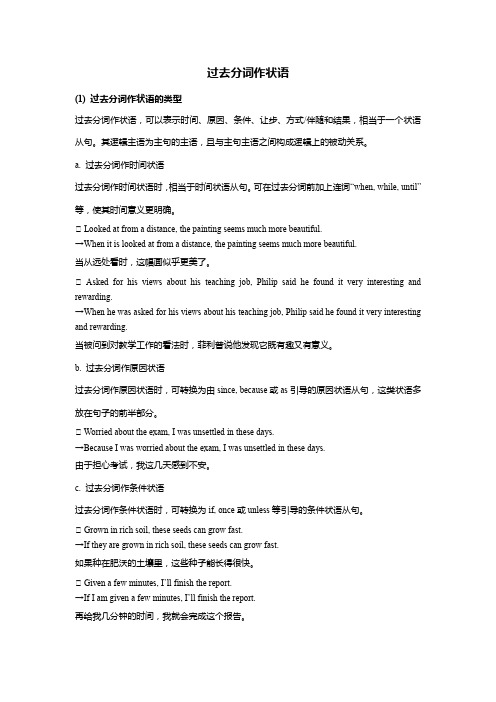
过去分词作状语(1) 过去分词作状语的类型过去分词作状语,可以表示时间、原因、条件、让步、方式/伴随和结果,相当于一个状语从句。
其逻辑主语为主句的主语,且与主句主语之间构成逻辑上的被动关系。
a. 过去分词作时间状语过去分词作时间状语时,相当于时间状语从句。
可在过去分词前加上连词“when, while, until”等,使其时间意义更明确。
◆ Looked at from a distance, the painting seems much more beautiful.→When it is looked at from a distance, the painting seems much more beautiful.当从远处看时,这幅画似乎更美了。
◆ Asked for his views about his teaching job, Philip said he found it very interesting and rewarding.→When he was asked for his views about his teaching job, Philip said he found it very interesting and rewarding.当被问到对教学工作的看法时,菲利普说他发现它既有趣又有意义。
b. 过去分词作原因状语过去分词作原因状语时,可转换为由since, because或as引导的原因状语从句,这类状语多放在句子的前半部分。
◆ Worried about the exam, I was unsettled in these days.→Because I was worried about the exam, I was unsettled in these days.由于担心考试,我这几天感到不安。
c. 过去分词作条件状语过去分词作条件状语时,可转换为if, once或unless等引导的条件状语从句。
过去分词短语作状语与主句主语
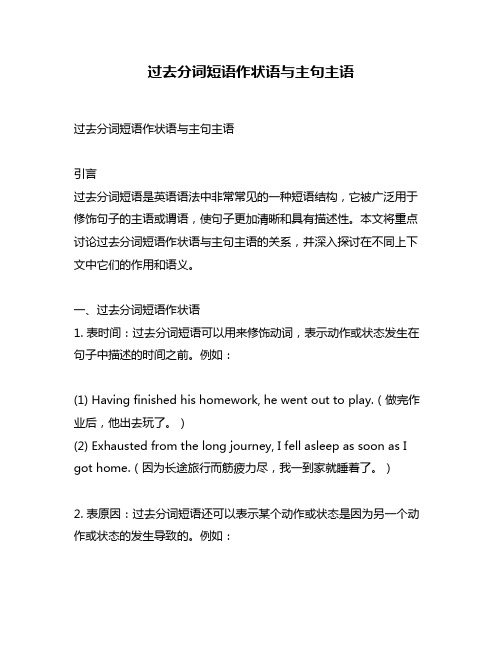
过去分词短语作状语与主句主语过去分词短语作状语与主句主语引言过去分词短语是英语语法中非常常见的一种短语结构,它被广泛用于修饰句子的主语或谓语,使句子更加清晰和具有描述性。
本文将重点讨论过去分词短语作状语与主句主语的关系,并深入探讨在不同上下文中它们的作用和语义。
一、过去分词短语作状语1. 表时间:过去分词短语可以用来修饰动词,表示动作或状态发生在句子中描述的时间之前。
例如:(1) Having finished his homework, he went out to play.(做完作业后,他出去玩了。
)(2) Exhausted from the long journey, I fell asleep as soon as I got home.(因为长途旅行而筋疲力尽,我一到家就睡着了。
)2. 表原因:过去分词短语还可以表示某个动作或状态是因为另一个动作或状态的发生导致的。
例如:(1) She missed the bus, being late for work.(她错过了公交车,因为迟到上班。
)(2) The team lost the match, having made too many mistakes.(由于犯了太多错误,队伍输掉了比赛。
)3. 表方式:过去分词短语可以描述动作的方式或方式。
例如:(1) He drove the car, carefully avoiding any obstacles.(他小心地开车,避开了任何障碍。
)(2) She completed the project, skillfully using her knowledge.(她运用自己的知识,熟练地完成了项目。
)二、过去分词短语作主句主语过去分词短语还可以作为主句的主语,这时它在句子中扮演的角色更加突出,通常表示被动或完成的动作。
1. 表示被动:过去分词短语作为主句主语时,通常表示主语所受到的动作或影响。
高中英语语法——过去分词作状语
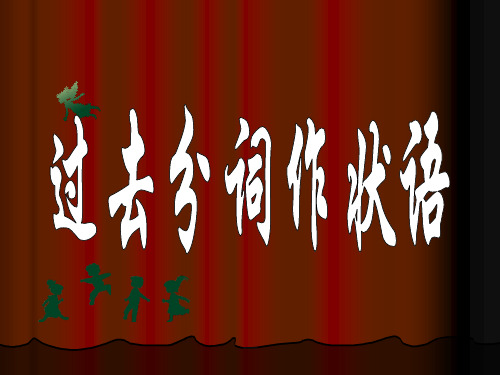
用括号内所给动词的适当形式填空。 1. __U_s_ e(duse) in this way, the word shouldn’t be taken as a verb. 2. __A__r_m__e(darm) with special guns, knives and brushes, two space walking astronauts practiced fixing the spacecraft. 3. Though ___c_a__u_g(hctatch) in a traffic jam, we managed to arrive at the airport. 4. Susan is not easy to get along with. But once _____ (ggaainine)d, her friendship will last forever.
2. 表示原因
表示原因,相当于由as, since, 或because 引导的原因状语从句.
Exhausted, the children fell asleep at once. =As they were exhausted, the children fell… Caught in a heavy rain, he was wet to the skin. =Because he was caught in a heavy rain, he
注意:可在过去分词前加上连词when, while, until等来强调过去分词所表示的动 作与主句谓语动词所表示动作的时间关系。
1. When it is heated, ice will be changed into water. When heated, ice will be changed into water.
英语语法--过去分词作状语(含练习)

2 作时间状语,等于when 引导时间从句,如果分词表示的动 作与谓语的动作同时发生,可在分词前加when/ while / until 等使时间意义更明确。 When heated , water can be changed into steam . Seen from the hill ,the park looks very beautiful .= ( When the park is seen from the hill…
语法:Past Participle As the adverbial 过去分作状语
3 作条件状语等于 if / whether 引导从句 Given more attention , the cabbages could have grown better .= ( If they have been given more attention …. Compared with you , we still have a long way to go = ( If we are compared with you …
United States .
A Being founded
B It was founded
C Founded
D Founding
3 Unless C__to speak ,you should remain silent at the conference .
A invited
过去分词做状语和定语时的区别

过去分词做状语和定语时的区别一、过去分词(短语)做状语1、与句子主语的关系当过去分词(短语)做状语时,要与句子的主语有关系,而且一般是被动关系。
在读下面所有的例句时,请注意过去分词短语与句子主语的关系。
先分析例句:Frightened by Santa Claus …words,Scrooge woke up.句子的主语是Scrooge,状语部分为Frightened by Santa Claus‟words,可以看出Scrooge是“被”Santa Claus的话“惊吓”(Frightened)。
2、在句子中的位置过去分词做状语,修饰的是句子中的位于,多放在句首,也可以放在后面,后者插在句子的中间。
Seen from the hill,the city looks magnificent.从山上看这座城市非常壮观。
They came in,followed by their wives.他们进来了,妻子们跟随在后。
Tom,horrified at what he had done,could at first say nothing.Tom对他做的事感到恐惧,一时说不出话来。
3、所表示的状语种类过去分词做状语可以表示伴随情况(即主句的谓语动作与状语同时发生)、表示原因、表示条件、也可以表示时间。
He entered,accompanied by his secretary.(伴随情况)他由秘书陪着走了进来。
Moved by his speech,many people volunteered to help in the work.(原因)由于受他讲话的感动,许多人自愿参加这项活动。
Taken in time,the medicine will be quite effective.(条件)如果及时服用,这种药是相当有效的。
Heated,water changes into steam.(时间)当被加热的时候,水可以变成蒸汽。
语法专题:过去分词作状语
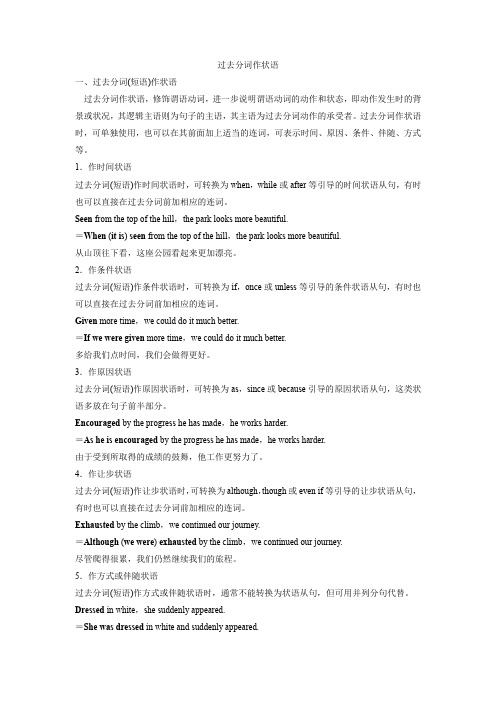
过去分词作状语一、过去分词(短语)作状语过去分词作状语,修饰谓语动词,进一步说明谓语动词的动作和状态,即动作发生时的背景或状况,其逻辑主语则为句子的主语,其主语为过去分词动作的承受者。
过去分词作状语时,可单独使用,也可以在其前面加上适当的连词,可表示时间、原因、条件、伴随、方式等。
1.作时间状语过去分词(短语)作时间状语时,可转换为when,while或after等引导的时间状语从句,有时也可以直接在过去分词前加相应的连词。
Seen from the top of the hill,the park looks more beautiful.=When (it is) seen from the top of the hill,the park looks more beautiful.从山顶往下看,这座公园看起来更加漂亮。
2.作条件状语过去分词(短语)作条件状语时,可转换为if,once或unless等引导的条件状语从句,有时也可以直接在过去分词前加相应的连词。
Given more time,we could do it much better.=If we were given more time,we could do it much better.多给我们点时间,我们会做得更好。
3.作原因状语过去分词(短语)作原因状语时,可转换为as,since或because引导的原因状语从句,这类状语多放在句子前半部分。
Encouraged by the progress he has made,he works harder.=As he is encouraged by the progress he has made,he works harder.由于受到所取得的成绩的鼓舞,他工作更努力了。
4.作让步状语过去分词(短语)作让步状语时,可转换为although,though或even if等引导的让步状语从句,有时也可以直接在过去分词前加相应的连词。
非谓语动词用法解析过去分词作状语

非谓语动词用法解析过去分词作状语非谓语动词用法解析——过去分词作状语过去分词作为一种非谓语动词形式,在英语语法中扮演着重要的角色。
它可以作为状语,修饰动词、形容词以及副词,起到更加精确和丰富的表达作用。
本文将对过去分词作状语的用法进行解析,并举例说明其在不同语境下的运用。
1. 过去分词作时间状语过去分词可以表示一个动作或状态的发生时间,常用于表示被动或完成的行为。
这种用法通常与表示时间的介词短语(如"after"、"before"、"since"、"when"、"while"等)搭配使用。
例1:Having finished her work, she went out for a walk.(完成了工作后,她出去散步了。
)例2:After being repaired, the car was as good as new.(修好后,这辆车好像新的一样。
)2. 过去分词作原因状语过去分词也可以表示一个动作或状态的原因。
它常用于表示被动、先行动作和结果的关系,通常与表示原因的介词短语(如"because of"、"due to"、"thanks to"等)搭配使用。
例1:Because of the heavy rain, the game was canceled.(因为下大雨,比赛被取消了。
)例2:Due to his hard work, he achieved great success.(由于他的努力,他取得了巨大的成功。
)3. 过去分词作方式状语过去分词还可以表示一个动作的方式或方式。
它常与表示方式的介词短语(如"by")或连词(如"as")搭配使用。
例1:He won the race by running faster than others.(他通过比其他人跑得更快赢得了比赛。
过去分词作状语
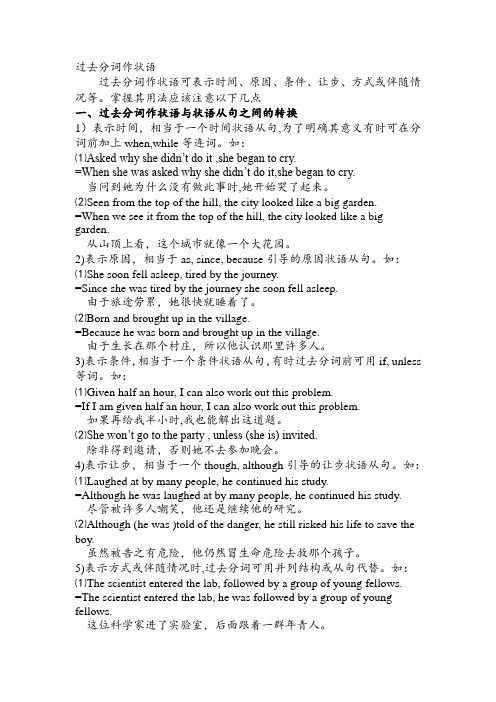
过去分词作状语过去分词作状语可表示时间、原因、条件、让步、方式或伴随情况等。
掌握其用法应该注意以下几点一、过去分词作状语与状语从句之间的转换1)表示时间,相当于一个时间状语从句,为了明确其意义有时可在分词前加上when,while等连词。
如:⑴Asked why she didn’t do it ,she began to cry.=When she was asked why she didn’t do it,she began to cry.当问到她为什么没有做此事时,她开始哭了起来。
⑵Seen from the top of the hill, the city looked like a big garden.=When we see it from the top of the hill, the city looked like a big garden.从山顶上看,这个城市就像一个大花园。
2)表示原因,相当于as, since, because引导的原因状语从句。
如:⑴She soon fell asleep, tired by the journey.=Since she was tired by the journey she soon fell asleep.由于旅途劳累,她很快就睡着了。
⑵Born and brought up in the village.=Because he was born and brought up in the village.由于生长在那个村庄,所以他认识那里许多人。
3)表示条件,相当于一个条件状语从句,有时过去分词前可用if, unless 等词。
如:⑴Given half an hour, I can also work out this problem.=If I am given half an hour, I can also work out this problem.如果再给我半小时,我也能解出这道题。
过去分词短语作状语

过去分词短语作状语非谓语动词是英语语言所特有的语言现象。
其中在学习分词的过程中应该明确,在大多数情况下分词只是从句的一种省略形式,目的在于使语言更为简练,尤其在书面语中。
所以无论是现在分词、还是过去分词都与从句的主动、被动、时态有着密切的关系。
过去分词短语在句中作状语可表示原因、时间、让步、条件、方式或伴随等。
例如:1.Praised by the neighbours, he became the pride of his parents.受到邻居们的表扬,他成为父母的骄傲。
(表示原因)2. Once seen, it can never be forgotten.一旦它被看见,人们就忘不了。
(表示时间)3.Seen from the top of the castle, the park looks very beautiful. (表示条件)从城堡顶端看,公园十分美丽4.Though told of the danger, he still risked his life to entered the cave.虽然被告之有危险,他仍然冒生命危险进山洞。
(表示让步)5.Filled with hopes and fears, he dived deep into the ocean.(表示伴随)心中充满了希望与恐惧,他跳进了深海里。
在使用过去分词作状语时, 为了体现上下两部分(句子层面)的逻辑关系, 句子中常出现过去分词和连词的连带使用,比如例2和例4那样的结构. 通过众多例句分析, 我们发现过去分词作状语以下几种情形:一、句子的主语与作状语用的过去分词之间在逻辑上是被动的关系例:_______ by the beauty of nature, the girl from London decided to spend another two days on the farm .(2004,辽宁)A.Attracting B.Attracted C. To be attracted D.Having attracted 分析:答案为B。
分词作状语的用法
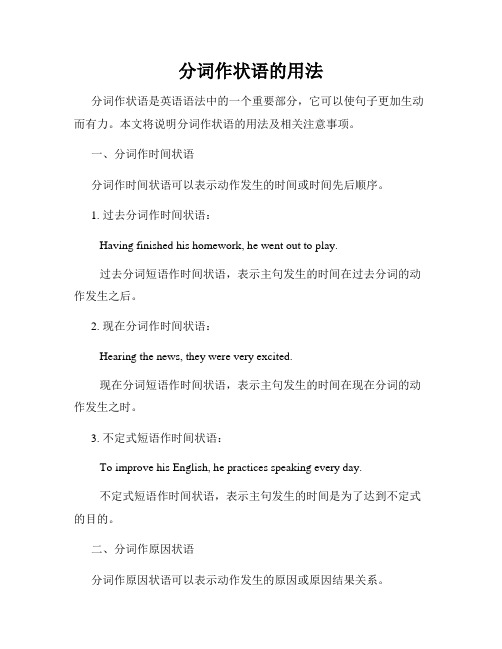
分词作状语的用法分词作状语是英语语法中的一个重要部分,它可以使句子更加生动而有力。
本文将说明分词作状语的用法及相关注意事项。
一、分词作时间状语分词作时间状语可以表示动作发生的时间或时间先后顺序。
1. 过去分词作时间状语:Having finished his homework, he went out to play.过去分词短语作时间状语,表示主句发生的时间在过去分词的动作发生之后。
2. 现在分词作时间状语:Hearing the news, they were very excited.现在分词短语作时间状语,表示主句发生的时间在现在分词的动作发生之时。
3. 不定式短语作时间状语:To improve his English, he practices speaking every day.不定式短语作时间状语,表示主句发生的时间是为了达到不定式的目的。
二、分词作原因状语分词作原因状语可以表示动作发生的原因或原因结果关系。
1. 过去分词作原因状语:Being tired, she decided to go to bed early.过去分词短语作原因状语,表示主句发生的原因是过去分词的动作。
2. 现在分词作原因状语:Seeing the dark clouds, they decided to bring umbrellas.现在分词短语作原因状语,表示主句发生的原因是现在分词的动作。
3. 不定式短语作原因状语:To save money, he stopped eating out.不定式短语作原因状语,表示主句发生的原因是不定式的目的。
三、分词作条件状语分词作条件状语可以表示动作发生的条件或条件结果关系。
1. 过去分词作条件状语:Given the chance, he would travel around the world.过去分词短语作条件状语,表示主句发生的条件是过去分词的动作。
什么时候过去分词作状语
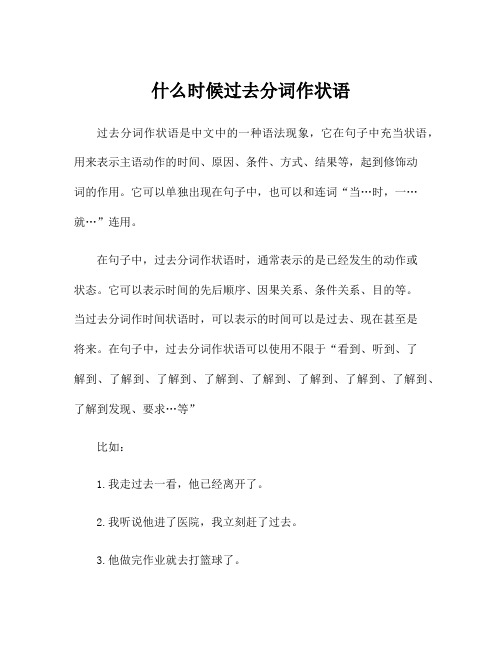
什么时候过去分词作状语
过去分词作状语是中文中的一种语法现象,它在句子中充当状语,用来表示主语动作的时间、原因、条件、方式、结果等,起到修饰动
词的作用。
它可以单独出现在句子中,也可以和连词“当…时,一…就…”连用。
在句子中,过去分词作状语时,通常表示的是已经发生的动作或
状态。
它可以表示时间的先后顺序、因果关系、条件关系、目的等。
当过去分词作时间状语时,可以表示的时间可以是过去、现在甚至是
将来。
在句子中,过去分词作状语可以使用不限于“看到、听到、了
解到、了解到、了解到、了解到、了解到、了解到、了解到、了解到、了解到发现、要求…等”
比如:
1.我走过去一看,他已经离开了。
2.我听说他进了医院,我立刻赶了过去。
3.他做完作业就去打篮球了。
4.太阳落山的时候,他还在工作。
过去分词作状语的句子有时候也可以通过改变主语的位置,将过
去分词置于主语之后,这样可以加强句子的逻辑关系,使句子更通顺。
这种句型通常通过“由于、因为、尽管、虽然、当…时,一…就…”
等连词连接。
比如:
1.由于工作繁忙,他常常加班到很晚。
2.因为生病了,他没能参加聚会。
3.虽然下雨了,但他照样去了操场。
总之,过去分词作状语是中文语法中的一种重要现象,它通过修
饰动词,增强了句子的信息量,使句子更加丰富和生动。
在写作中,
我们可以通过增加过去分词作状语的句式结构,使句子更加多样化,
达到丰富语言表达的目的。
过去分词作定语和状语的用法总结
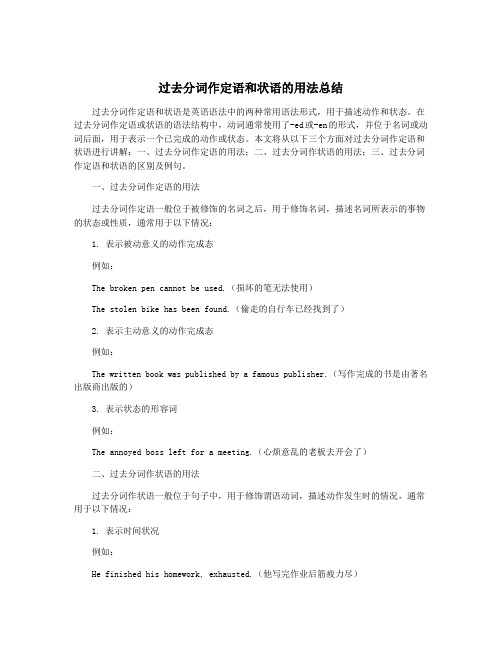
过去分词作定语和状语的用法总结过去分词作定语和状语是英语语法中的两种常用语法形式,用于描述动作和状态。
在过去分词作定语或状语的语法结构中,动词通常使用了-ed或-en的形式,并位于名词或动词后面,用于表示一个已完成的动作或状态。
本文将从以下三个方面对过去分词作定语和状语进行讲解:一、过去分词作定语的用法;二、过去分词作状语的用法;三、过去分词作定语和状语的区别及例句。
一、过去分词作定语的用法过去分词作定语一般位于被修饰的名词之后,用于修饰名词,描述名词所表示的事物的状态或性质,通常用于以下情况:1. 表示被动意义的动作完成态例如:The broken pen cannot be used.(损坏的笔无法使用)The stolen bike has been found.(偷走的自行车已经找到了)2. 表示主动意义的动作完成态例如:The written book was published by a famous publisher.(写作完成的书是由著名出版商出版的)3. 表示状态的形容词例如:The annoyed boss left for a meeting.(心烦意乱的老板去开会了)二、过去分词作状语的用法过去分词作状语一般位于句子中,用于修饰谓语动词,描述动作发生时的情况,通常用于以下情况:1. 表示时间状况例如:He finished his homework, exhausted.(他写完作业后筋疲力尽)She stood there, frozen with fear.(她站在那里,惊恐万分)2. 表示原因或结果例如:Having saved enough money, he bought a new car.(存够了钱,他买了一辆新车)Being late for the meeting, they missed their chance.(因为迟到,他们错过了机会。
)3. 表示条件状况例如:Having finished the task, he went home.(完成任务后,他回家了)三、过去分词作定语和状语的区别及例句过去分词作定语和状语的最大区别在于它们所修饰的词不同。
语法--过去分词作状语

2) 过去分词作状语时,过去分词所表示的动 作与句子主语之间构成逻辑上的_被__动_关系。
e.g. _G_i_v_e_n_m__o_r_e_e_n_c_o_u_r_a_g_e_m__e_n_t , the boy could have behaved better. 如果多给这个孩子一些鼓励,他本来会 表现得更好。 _F_a_c_e_d_w__it_h_d__if_fi_c_u_l_ti_e_s, we must try to overcome them. 在遇到困难时,我们必须设法克服。
III. 将下列句子翻译成英语。 1. 由于被妈妈所说的话所感动,我忍不
住哭了起来。
Moved by what my mother said, I couldn’t help crying. 2. 如果给我们一个机会,我们将给大家 一个非常好的表演。 Given a chance, we could give a good performance.
then taken to see the Bird’s Nest for the
2008 Olympic Games.
A. Having shown
B. To be shown
C. Having been shown D. To show 【点拨】答案为C。我们参观鸟巢前已
经被带着参观了水立方。
考点三:“连词 + 过去分词”作状语
1. 过去分词作状语表示被动或完成,但 有些过去分词(短语)因来源于系表结 构,作状语时不表动作而表状态。这 样的过去分词(短语)常见的有: lost (迷 路); seated (坐); absorbed in (全神贯注 于); dressed in (穿着); tired of (厌烦) 等。如:
高中英语语法 过去分词作状语

3.Because he was seriously injured , he had to be taken to hospital. = Seriously injured , he had to be taken to hospital. 4.Because it was written in a hurry, this article was not so good. = Written in a hurry, this article was not so good.
归纳: 过去分词作方式或伴随状语,可 转换为并列句。
练习1: P46 练习2:还原 1._____(ask) about his family, he made no answer. 2.____ (see) from the top of the hill, the city looks more beautiful. 3.seriously ____ (injure) , he had to be taken to hospital. 4._____ (write) in a hurry, this article was not so good.
与Ving作状语的区别
1.He picked up a wallet while he was walking home. =He picked up a wallet while walking home. 2.While we were swimming in the river, we saw a fish jump out of the river. =While swimming in the river, we saw a fish jump out of the river.
过去分词做状语
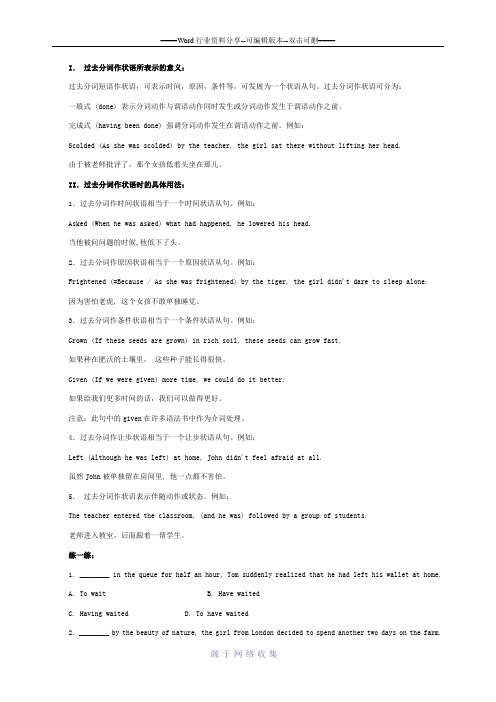
I.过去分词作状语所表示的意义:过去分词短语作状语,可表示时间,原因,条件等,可发展为一个状语从句。
过去分词作状语可分为:一般式 (done) 表示分词动作与谓语动作同时发生或分词动作发生于谓语动作之前。
完成式 (having been done) 强调分词动作发生在谓语动作之前。
例如:Scolded (As she was scolded) by the teacher, the girl sat there without lifting her head.由于被老师批评了,那个女孩低着头坐在那儿。
II.过去分词作状语时的具体用法:1.过去分词作时间状语相当于一个时间状语从句。
例如:Asked (When he was asked) what had happened, he lowered his head.当他被问问题的时候,他低下了头。
2.过去分词作原因状语相当于一个原因状语从句。
例如:Frightened (=Because / As she was frightened) by the tiger, the girl didn't dare to sleep alone.因为害怕老虎, 这个女孩不敢单独睡觉。
3.过去分词作条件状语相当于一个条件状语从句。
例如:Grown (If these seeds are grown) in rich soil, these seeds can grow fast.如果种在肥沃的土壤里,这些种子能长得很快。
Given (If we were given) more time, we could do it better.如果给我们更多时间的话,我们可以做得更好。
注意:此句中的given在许多语法书中作为介词处理。
4.过去分词作让步状语相当于一个让步状语从句。
例如:Left (Although he was left) at home, John didn't feel afraid at all.虽然John被单独留在房间里, 他一点都不害怕。
过去分词短语作状语

过去分词短语作状语非谓语动词是英语语言所特有的语言现象。
其中在学习分词的过程中应该明确,在大多数情况下分词只是从句的一种省略形式,目的在于使语言更为简练,尤其在书面语中。
所以无论是现在分词、还是过去分词都与从句的主动、被动、时态有着密切的关系。
过去分词短语在句中作状语可表示原因、时间、让步、条件、方式或伴随等。
例如:1.Praised by the neighbours, he became the pride of his parents.受到邻居们的表扬,他成为父母的骄傲。
(表示原因)2. Once seen, it can never be forgotten.一旦它被看见,人们就忘不了。
(表示时间)3.Seen from the top of the castle, the park looks very beautiful. (表示条件)从城堡顶端看,公园十分美丽4.Though told of the danger, he still risked his life to entered the cave.虽然被告之有危险,他仍然冒生命危险进山洞。
(表示让步)5.Filled with hopes and fears, he dived deep into the ocean.(表示伴随)心中充满了希望与恐惧,他跳进了深海里。
在使用过去分词作状语时, 为了体现上下两部分(句子层面)的逻辑关系, 句子中常出现过去分词和连词的连带使用,比如例2和例4那样的结构. 通过众多例句分析, 我们发现过去分词作状语以下几种情形:一、句子的主语与作状语用的过去分词之间在逻辑上是被动的关系例:_______ by the beauty of nature, the girl from London decided to spend another two days on the farm .(2004,辽宁)A.Attracting B.Attracted C. To be attracted D.Having attracted分析:答案为B。
过去分词作状语的诗歌

过去分词作状语的诗歌一、过去分词作状语表示被动的和完成的动作。
1.Written in a hurry,this article was not so good!因为写得匆忙,这篇文章不是很好。
2.Lost / Absorbed in deep thought,he didn't hear the sound.因为沉溺于思考之中,所以他没听到那个声音。
二、过去分词作状语时其逻辑主语为主句的主语,此时应注意人称一致;1.Given another hour,I can also work out this problem.再给我一个小时,我也能解这道题.(given 为过去分词作状语,它的逻辑主语为主句主语I,即I 被再给一个小时。
)2.Seen from the top of the hill,the city looks more beautiful to us.从山顶看城市,城市显得更漂亮。
(seen 为过去分词作状语,表"被看",由语境可知,它的逻辑主语必须是城市,而不是"我们",因为"我们"应主动看城市。
)需要注意的是:如果过去分词作状语时,前面再加逻辑主语,主句的主语就不再是分词的逻辑主语,这种带逻辑主语的过去分词结构实际上属于独立主格结构。
3.The signal given,the bus started.信号一发出,汽车就开动了。
(the signal 是given 的逻辑主语,因此主句主语the bus 就不是given 的逻辑主语。
4.Her head held high,she went by.她把头昂得高高地从这儿走了过去。
(her head 是held high 的逻辑主语,因此主句主语she 就不再是held high 的逻辑主语。
)三、过去分词作状语来源于状语从句.1.Caught in a heavy rain,he was all wet.因为淋了一场大雨,所以他全身湿透了。
- 1、下载文档前请自行甄别文档内容的完整性,平台不提供额外的编辑、内容补充、找答案等附加服务。
- 2、"仅部分预览"的文档,不可在线预览部分如存在完整性等问题,可反馈申请退款(可完整预览的文档不适用该条件!)。
- 3、如文档侵犯您的权益,请联系客服反馈,我们会尽快为您处理(人工客服工作时间:9:00-18:30)。
过去分词(done)作状语
3.作条件状语 __G_iv_e_n___(give) another hour, I can finish it.
解题步骤1、找主语 2、判关系
(If I am) given another hour, I can finish it.
过去分词(done)作状语
4.作让步状语 _B_e_a_t_e_n__(beat) by the other team, we didn't lose heart.
worried
______with the service that the businessman provied, he decided to cooperate with him. 由于对那个商人提供的服务感到满意,他决定与他 合作hen ______ (inform) of the exciting news, we couldn't help jumping with joy. 2. The old man entered the meeting room, ______ (suppport) by his granddaugher. 3. ____ (tire) of the life in the city, they went back to their hometown in the countryside. 4. Though ______(warn) not to smoke after the operation, the patient smoked all the same.
Module 5 Unit3 Life in the future
语法:过去分词作状语
龙南中学 袁微
过去分词(done)是非谓语动词中的一种
非谓语动词
不定式 (to do ) 现在分词 (doing) 过去分词(done)
回顾英语五种基本句型
• 1. 主 谓 He runs (quickly).
过去分词(done)作状语
1. 作时间状语 2. 作原因状语 3.作条件状语 4.作让步状语 5.作方式或伴随状语
过去分词(done)作状语
1.作时间状语
once __p__u_b_li_s_h_e_d___(publish), the book will be very
popular.
解题步骤1、找主语 2、判关系
• 2. doing 表主动; done 表被动 试改错: • 1. When asking why he was late, the boy cried.
asked
• 2. Looked out of the window, I saw some Looking
students playing there.
解题步骤1、找主语 2、判关系
(Though we are )beaten by the other team, we didn't lose heart.
过去分词(done)作状语
4.作方式或状语 The old man got on the bus,s_u_p_p_o_r_t_e_d___(support) by a girl.
5.I told a lie when _____(questioned) at the meeting by my boss. 6. ________(scold) by the teacher, the girl began to cry. 7. ______another chance, the _____ boy jumped with joy. 被给再一次机会,那个激动的男孩高兴得 跳了起来。
解题步骤1、找主语 2、判关系
The old man got on the bus, (and he was) supported by a girl
注意事项
• 1. 过去分词作状语时,其前面可以带有相应 的连词,如when, (al)though, as if, as though, if, unless, until, once等,表时间、让步、条件、 方式等。 • If_in_v_i_te_d__(invite), I will attend the wedding of my friend.
once (it is) published, the book will be very popular.
过去分词(done)作状语
2.作原因状语
_L_o_s_t ___(lose) in thought, I didn't hear the
phone.
解题步骤1、找主语 2、判关系
(Because I was) lost in thought, I didn't hear the phone.
• 2. 主 系 表 You are smart.
• 3. 主 谓 宾 He eats an apple.
• 4. 主 谓 间宾 直宾 He gives me an apple.
• 5. 主 谓 宾 宾补 We should keep the classroom clean.
有没有这种句型呢?
主谓谓?
一山可容二虎?
1. 主 谓 2. 主 系 表 3. 主 谓 宾 4. 主 谓 间宾 直宾 5. 主 谓 宾 宾补
一个家庭可以一有山 两个妻子吗?
小三!!!
哪三种非谓语动词(小三)?
试翻译三个简单的句子 1. 我想买本书。 2. 我爱打篮球。 3. 这车是中国制造。
总结
to do 表_主__动_、将__来__、目__的__ doing 表_主__动_、进__行__、伴__随__ done 表被__动__、完__成__
• 3. Seeing from the space, the earth is a blue ball. Seen
• 3.有些过去分词已经形容词化,作状语时表示人的 状态。常见的有satisfied, surprised, interested, moved, worried, pleased, disappointed等。 • _____ about her safety, he can't fall asleep. 因为担心她的安全,他睡不着。
